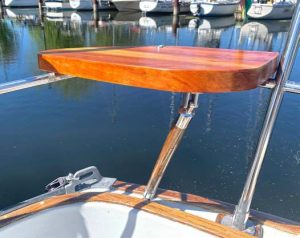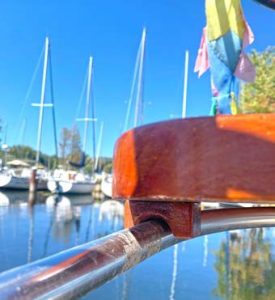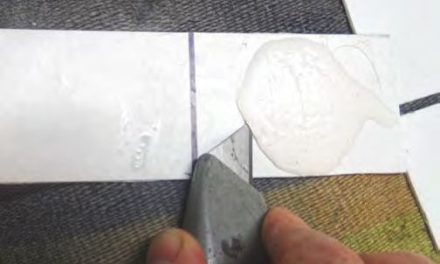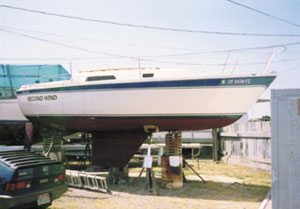An inexpensive cure for a crowded cockpit
Issue 155: March/April 2024
We are seasonal sailors on the Great Lakes, and summer is a time for having fun with our family and friends. We love having guests aboard our C&C 30 Mk1, Juniper, for daysailing adventures with drinks and snacks, but with our family of four and a few guests, the cockpit quickly becomes very crowded and hard to move around in.
To remedy this problem, we added wooden seats to our stern rail to allow crew members or guests to sit up and farther aft. The seats provide a place for passengers to view the action while sailing, but also remain comfortable and out of the way.
This is a simple upgrade that will dazzle your guests and increase comfort for your own passages. Homemade stern seats are the perfect addition to many boats and are highly customizable to meet your specific needs. Most projects we set out to do on the boat take longer and cost more than we anticipate, but these seats were easy to make and on budget.

The completed stern seat on Juniper’s starboard side. A wood dowel complements the wood of the seat.
To get started, we created a cardboard template for the seat so we could play around with the appropriate size, shape, and position. Once we had a template we were happy with and that worked well for Juniper’s cockpit, we traced the shape onto a piece of wood. We used a piece of 1-inch cherry that we had sitting in our basement, but many other types of wood should work just fine. Ideally, you’ll want to choose something that matches your boat’s aesthetic and is sturdy enough to weather the elements.
When the tracing was done, we used a jigsaw to cut and shape the seats. We also cut two support pieces for each seat to provide a sturdy and solid fit — the supports are small wooden blocks that match the curvature of the rail they rest on.
With the seats cut, it was time to gather the proper hardware, which we sourced from Go2Marine, Amazon, and a local hardware store. The parts we used should work for most boats and included one Sea-Dog rail mount bracket ($10), two bimini deck hinge mounts ($15), two bimini top cap fittings ($13), a wooden dowel ($5), and wood for the seats (variable).
We then attached the rail mount bracket to the aft curve of the seat and placed the support pieces at outside points, attaching them with a screwdriver. Next, we attached the bimini hinge mount to the deck in a spot just aft of the coaming, using butyl tape around the screws to ensure the hinge does not cause any leaks. Then we attached the second hinge mount underneath and to the outermost part of the seat. Once this was done, we measured the wood dowel to length and shaped the ends to fit snugly in the cap fittings.

Support blocks were added to ensure the seats do not wobble on the rail.
Now it was time to make all the wood pieces look nice and give them some protection from the elements. We disassembled all the hardware pieces and gave them a coat of varnish (you can use your preferred varnish and apply as many coats as you deem appropriate).
With the varnish dry, we reattached the seat to the rail mount and connected the hinges to the caps to complete the installation. After the seats were in place, we sat back and enjoyed great visibility and a comfortable place to take in the wind and the waves.
The new seats have given the captain space to sail the boat, while enabling our guests to be present without being in the way. Coming in at about $40 per seat, these are easily one of our favorite improvements we’ve made to our good old boat.
Allie is an adventure enthusiast who loves exploring this beautiful world with her husband and two children aboard their C&C 30 Mk1, Juniper. They sail the Great Lakes from their home port of Muskegon, Michigan.
Thank you to Sailrite Enterprises, Inc., for providing free access to back issues of Good Old Boat through intellectual property rights. Sailrite.com





